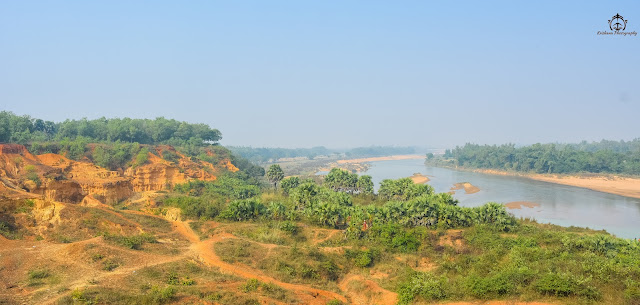আমার বাংলা
ইতিহাস
গ্ৰাম গঞ্জে
ভ্রমণ
Gangani - The Grand Canyon of Bengal
On the outskirts of
the Garhbeta town in West Medinipur district of West Bengal, lies a beautiful
anomaly of nature. The plain landscape that marks the area of West Bengal is
disrupted here by tall gorges formed over thousands of years by the Silabati River.
The wide red soil gorge is locally called 'Gongoni Danga' or 'Gongoni Khola'.
Formed after a long period of natural soil erosion and river movement, the
Gangani Gorge is a beautiful and unique marvel that is frequented by locals and
tourists alike.
Just a few hours away from Kolkata,
Gangani is a destination that brings together a stunning coalition of green
forests, sandstone hills and fertile riverbeds. When monsoons arrive, the
Silabati River can be seen flowing through the Gangani (Gongoni) Gorge, which
is known to resemble the Grand Canyon of Arizona. Government authorities
recently built a staircase at the highest point of Gangani that goes all
the way down to the river, and when its not raining, you can even cross the
river on foot as the water is not too deep.
How to
reach :-
Gangani
is easily accessible from Kolkata by both road and rail. You can either take a
road trip till here or cover the distance on a scenic train ride.
By
road: If you have decided to drive down to the 'Grand Canyon of
West Bengal', then take the NH6 from Kolkata all the way to Uluberia via
Bagnan. From there you can take two different routes, either go towards
Chandrakona Town via Ghatal or Salboni via NH60. Gangani is just a few
kilometers from either of the towns.
By
train: The nearest town to Gangani is Garhbeta, which has its own
railway station. All you need to do is board the Rupashi Bangla Express from
Satragachhi Station at Howrah and get off at Garbeta Station after a few hours.
Where
to stay :-
There are no accommodation
option available at Gangani exactly, but the nearby towns of Garhbeta and
Bishnupur have a few hotels that you can stay at. Garhbeta Town is fairly
developed, and you will have access to all basic facilities.
Places
to see around Gangani :-
Sarbamangala Mandir: The Sarbamangala Mandir is a 16th century temple built by
the Bagri king, Nripati Singha. The temple is dedicated to the goddess Durga,
whose idol here is carved out of basalt stone. The complex is also a fine
example of unique Oriya architecture.
Raikota Fort: Built somewhere between 1555-1610 AD by the Chauhan Rajas of
Bagri, the Raikota Fort is remnant of the glorious Oriya architecture. Though
all that remains now are ruins, but it still makes for a great spot to watch
the sun go down.
Bagri's Krishnarai Jiu Temple: The areas around Gangani are primarily
known for being home to ancient temples. Bagri's Krishnarai Jiu is one of such
temples that holds great spiritual and traditional value for locals. Made out
of black basalt stone, the temple was built by Rajyadhar Roy, a minister of the
Bagri king, Gajapati Singha.
Heads
up
Gangani (pronounced
'Gongoni') is not exactly a hidden destination for people in West Bengal. From
school kids to rowdy teenagers, a large variety of groups find their way to the
shores of Silabati River to have a good time. So don't expect Gangani to be an
isolated and quiet corner in the lap of nature. But you can be a little clever
about planning your trip so you reach at a time when it's not crowded. A
suggestion would be to reach Gangani at the crack of dawn and witness the
sunrise here for a beautiful and peaceful experience.


























No comments